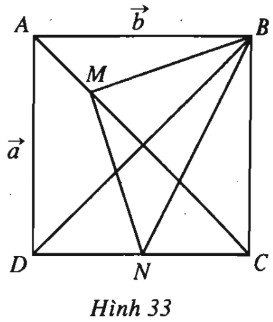Bài 23 trang 41 SBT Hình học 10 Nâng cao
Giải bài tập Bài 23 trang 41 SBT Hình học 10 Nâng cao
Cho hình vuông \(ABCD\), điểm \(M\) nằm trên đoạn thẳng \(AC\) sao cho \(AM = \dfrac{{AC}}{4}\). Gọi \(N\) là trung điểm của đoạn thẳng \(DC\). Chứng minh rằng \(BMN\) là tam giác vuông cân.
Giải

Đặt \(\overrightarrow {AD} = \overrightarrow a , \overrightarrow {AB} = \overrightarrow b .\) Khi đó, ta có
\(\overrightarrow {AM} = \dfrac{1}{4}\overrightarrow {AC} = \dfrac{1}{4}(\overrightarrow a + \overrightarrow b ),\)
\( \overrightarrow {AN} = \overrightarrow {AD} + \overrightarrow {DN} = \overrightarrow a + \dfrac{{\overrightarrow b }}{2}.\)
Từ đó suy ra
\(\begin{array}{l}\overrightarrow {MB} = \overrightarrow {AB} - \overrightarrow {AM}\\ = \overrightarrow b - \dfrac{1}{4}(\overrightarrow a + \overrightarrow b )\\ = \dfrac{1}{4}( - \overrightarrow a + 3\overrightarrow b ).\\\overrightarrow {MN} = \overrightarrow {AN} - \overrightarrow {AM}\\ = \overrightarrow a + \dfrac{{\overrightarrow b }}{2} - \dfrac{1}{4}(\overrightarrow a + \overrightarrow b ) \\= \dfrac{1}{4}(3\overrightarrow a + \overrightarrow b ).\end{array}\)
Ta có
\(\begin{array}{l}\overrightarrow {MB} .\overrightarrow {MN}\\ = \dfrac{1}{{16}}( - \overrightarrow a + 3\overrightarrow b )(3\overrightarrow a + \overrightarrow b )\\= \dfrac{1}{{16}}\left( { - 3\overrightarrow a + 3\overrightarrow b + 8\overrightarrow a .\overrightarrow b } \right) = 0.\\{\overrightarrow {MB} ^2} = \dfrac{1}{{16}}( - \overrightarrow a + 3\overrightarrow b ) \\= \dfrac{1}{{16}}({\overrightarrow a ^2} + 9{\overrightarrow b ^2} - 6\overrightarrow a .\overrightarrow b ) = \dfrac{5}{8}{\overrightarrow a ^2}.\\{\overrightarrow {MN} ^2} = \dfrac{1}{{16}}{\left( {3\overrightarrow a + \overrightarrow b } \right)^2}\\ = \dfrac{1}{{16}}\left( {9{{\overrightarrow a }^2} + {{\overrightarrow b }^2} + 6\overrightarrow a .\overrightarrow b } \right)\\ = \dfrac{5}{8}{\overrightarrow a ^2}.\end{array}\)
Vậy \(MB \bot MN\) và \(MB=MN\), tam giác \(BMN\) vuông cân tại đỉnh \(M.\)
Sachbaitap.com
Bài viết liên quan
Các bài khác cùng chuyên mục
- Bài 1, 2, 3, 4, 5, 6 trang 123, 124 SBT Hình học 10 Nâng cao (29/09)
- Bài 7, 8, 9, 10, 11, 12 trang 124, 125 SBT Hình học 10 Nâng cao (29/09)
- Bài 13, 14, 15, 16, 17 trang 126 SBT Hình học 10 Nâng cao (29/09)
- Bài 23, 24, 25, 26, 27 trang 127, 128 SBT Hình học 10 Nâng cao (29/09)
- Bài 18, 19, 20, 21, 22 trang 126, 127 SBT Hình học 10 Nâng cao (29/09)
- BÀI TẬP ÔN TẬP CUỐI NĂM - ĐẠI SỐ 10 NÂNG CAO
- Bài tập Ôn tập chương VI – Góc lượng giác và công thức lượng giác
- Bài 4. Một số công thức lượng giác
- Bài 3. Giá trị lượng giác của các góc (cung) có liên quan đặc biệt
- Bài 1 + 2. Góc và cung lượng giác. Giá trị lượng giác của góc (cung) lượng giác
- CHƯƠNG VI. GÓC LƯỢNG GIÁC VÀ CÔNG THỨC LƯỢNG GIÁC
- Bài tập Ôn tập chương V - Thống kê
- Bài 3. Các số đặc trưng của mẫu số liệu
- Bài 1+2. Một vài khái niệm mở đầu. Trình bày một mẫu số liệu
- CHƯƠNG V. THỐNG KÊ
- Bài 22 Đọc mở rộng trang 111 SGK Tiếng Việt 5 Kết nối tri thức tập 2
- Bài 22 Luyện viết đoạn văn thể hiện tình cảm, cảm xúc về một sự việc trang 111 SGK Tiếng Việt 5 Kết nối tri thức tập 2
- Bài 22 Bộ đội về làng trang 109 SGK Tiếng Việt 5 Kết nối tri thức tập 2
- Bài 21 Viết đoạn văn nêu ý kiến tán thành một sự việc, hiện tượng (Bài viết số 2) trang 108 SGK Tiếng Việt 5 Kết nối tri thức tập 2
- Bài 21 Luyện tập về câu ghép trang 107 SGK Tiếng Việt 5 Kết nối tri thức tập 2
- Bài 21 Anh hùng lao động Trần Đại Nghĩa trang 106 SGK Tiếng Việt 5 Kết nối tri thức tập 2
- Bài 20 Đền ơn đáp nghĩa trang 104 SGK Tiếng Việt 5 Kết nối tri thức tập 2
- Bài 20 Đánh giá, chỉnh sửa đoạn văn nêu ý kiến tán thành một sự vật, hiện tượng trang 103 SGK Tiếng Việt 5 Kết nối tri thức tập 2
- Bài 20 Cụ Đồ Chiểu trang 101 SGK Tiếng Việt 5 Kết nối tri thức tập 2
- Bài 19 Viết đoạn văn nêu ý kiến tán thành một sự việc, hiện tượng (Bài viết số 1) trang 100 SGK Tiếng Việt 5 Kết nối tri thức tập 2
 Tải app loigiaihay.com cho Android để lưu và xem mà không cần mạng!
Tải app loigiaihay.com cho Android để lưu và xem mà không cần mạng!
